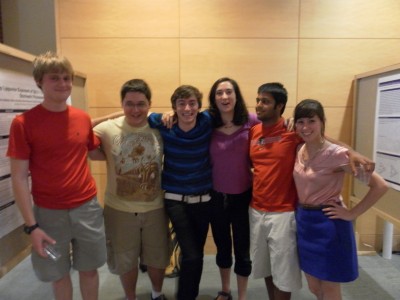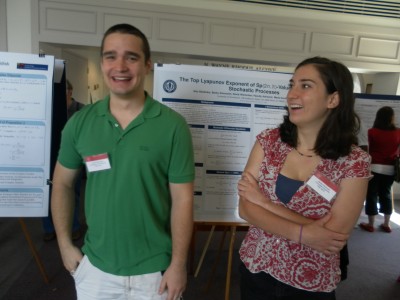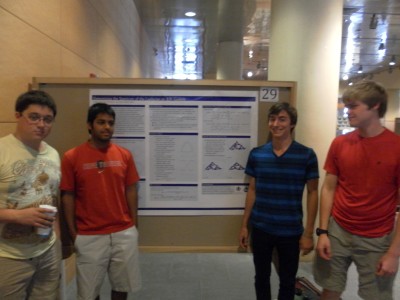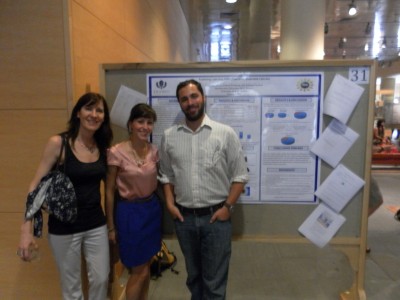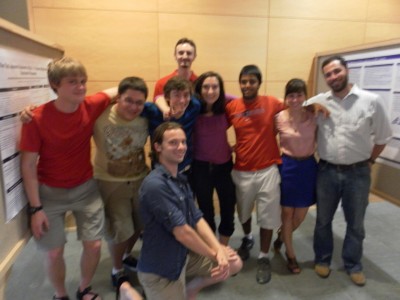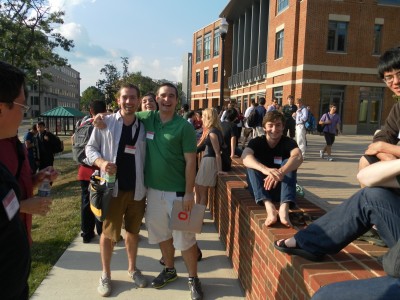Research
Goals
The primary function of our program is to involve undergraduate students in mathematical research. During the summer of 2012, there were four research projects. For each project the students would meet five times a week with the senior researchers involved in that specific project. Each project had an aspect of presenting the research, whether that meant preparing a paper for publication or presenting for other students and colleagues.
Fractals (Project Link)
The fractal research program had two focuses for the summer of 2012: to work on a research project and to create computer programs which would make the research area of analysis on fractals more accessible for non-experts and non-mathematicians to understand.
The research project was to compute the spectrum of the Laplacian on 3N-gasket fractals. The Laplacian is the central object used in analysis on fractals, and computing the spectrum allows us to answer many questions that naturally arise in this analysis. 3N-gaskets are particularly interesting because they are an infinite family of fractals, and the calculation of the spectrum on these fractals involves complicated dynamics that has only been seen in a handful of cases.
The computer programs which the students wrote perform complicated theoretical computations for a broad class of fractals. For example, they wrote a program which produces the graph approximations of n-gasket fractals, as well as approximations to their Laplacian operators. This is the first step in performing finite element method experiments on these fractals, thus allowing other researchers to use these graphs in their work. Toward helping understand analysis on fractals, a large focus has been placed on visualizations while writing these programs. Many of these can be found on the materials page.
Mathematics Education (Project Link)
The goal of the mathematics education research project for the summer of 2012 was to give our student a sense of the flow of an education study. Starting with the inception and design, followed by understanding ethical ramifications and applications for appropriate approvals and permissions, administering and writing up a report, and ending in creating materials based on the study to implement in the classroom to further educational outcomes.
This pilot study used student perceptions about their understanding of mathematics to guide the development of learning aids for multivariable calculus classes. Studies on the use of computer technology in advanced mathematics classrooms have shown that technology can help with the understanding of abstract concepts (Godaszi, Elahe Aminifar, & Bakhshalizadeh, 2009; Verner, Aroshas, & Berman, 2008). In addition, other researchers have found that using real-world applications and Inquiry Based Learning (IBL) projects can also help students not only with their learning but also with their enjoyment of mathematics (Hassi & Laursen, 2009; Spronken-Smith, Walker, Batchelor, O’Steen, & Angelo, 2012; Stillman, Galbraith, Brown, Edwards, 2007). In this study, these approaches were used in conjunction with students’ perceptions (Pierce, Stacey, & Barkatsas, 2007; Schoenfeld, 1989; Szydlik, 2000) to develop learning aids for multivariable calculus.
Stochastics (Project Link)
The goal of the Stochastic processes research project was to determine the dynamic properties of random processes on the symplectic group, a matrix Lie group, and symplectic manifold. In particular they were interested in the Lyapunov exponent of the stochastic dynamical system, which is the quantity which governs the spread of the system if the initial conditions are perturbed.
We consider the stability of matrix Lie group valued stochastic differential equations, dXt = AXt dt + BXtdt. Random dynamical systems such as this arise in many applications (e.g., oceanic turbulence, helicopter blade motion, light in random channels, wireless networks) in which stability is of practical and theoretical concern. The stability of the zero solution, Xt = 0, is determined by the top Lyapunov exponent. But in practice, analytic calculations of the Lyapunov exponent are often impossible, so time discrete approximations and simulations are necessary. Oceledet’s famous multiplicative ergodic theorem ensures that the Lyapunov exponent of Xt is almost surely constant. But the Lyapunov exponent of a time discrete approximation is itself a random variable. The mean of this random variable has been studied. We provide estimates on the variance, distribution and rate of convergence in certain numerical approximation methods. In addition, we expand on and provide simulations for recent results regarding the top Lyapunov exponent of certain Lie group valued SDEs.
Algebraic Geometry (Project Link)
A toric variety is an algebraic variety containing the algebraic torus (C*)n as an open dense subset such that the action of the torus extends to the whole variety. Every n-dimensional toric variety can be associated to a fan, which can be given as a set of primitive vectors in an n-dimensional lattice N. Because of this association, many properties of toric varieties can be studied using combinatorial methods. This group was interested in determining which projective toric varieties are Frobenius split. If a projective toric variety is Frobenius split, it has many nice properties. For example, it can be given as the solution set to homogeneous degree two polynomials.
Sam Payne proved in 2008 that a toric variety is Frobenius split if and only if an associated polytope called the splitting polytope contains representatives of every residue class of (1/q)M/M where M is the dual lattice to N. The group’s goal was to use this characterization of Frobenius splitting to classify the Frobenius split projective toric varieties in n dimensions. Given a trivalent tree where edges are labeled with variables and integers, it’s possible to construct the fan of a toric variety. They determined which toric varieties arising in this way are Frobenius split for certain classes of edge labelings.
Academic Development
Goals
Aiding the students in their academic development is a key goal of our program, as it forms a solid foundation for a career in math and science. Advancing students in their academic background comes in several forms: broadening the knowledge base, understanding the flow of academic life, and best practices for research.
Seminars
Throughout the course of the summer we invited experienced researchers to give talks about their work or other subjects that interested them. In total, 10 seminars were held. This included tutorials in the computer algebra language Mathematica as well as the typesetting language LaTeX, which is necessary to learn for anyone who wishes to publish scholarly mathematical articles.
These seminars were open to the public to encourage faculty members as well as graduate and undergraduate students from UConn and other schools to attend. The motivation for this was to stimulate discussion about the topics presented as well as to make the program part of the math and science communities at the University of Connecticut.
Graduate School Preparation
One of the key aspects in developing the academic background of a student is to help them navigate the academic world. The foremost priority is preparation for graduate school since for most of our students this is the next step. This includes how to pick the appropriate program, what materials are necessary to apply, and what graduate student life is like.
To this effect we organized a panel of graduate students in mathematics and mathematics education to discuss all of the above concerns. The focus was to have an informal discussion about the concerns that the program participants had as they considered their graduate career. It was an excellent way to get students talking to others about their concerns, and give them answers for their questions and guidance for the future.
Of course, guidance and mentorship does not end with the coming of September and we do our best to keep in touch with all of our students after the program has ended.
Ethics Training
Becoming part of the scientific community entails becoming acquainted with the best practices for performing scientific research, especially when these best practices concern academic honesty and decency. To further our students understanding in this area, we attended a session on the ethics of scientific research along with the other REU programs on the UConn campus. This program allowed students to ask questions and see examples of what sort of ethical dilemmas a researcher faces, and how to deal with these difficulties as they arise.
Community
Goals
Part of creating a successful summer program is fostering a strong sense of community among the students, and involving the students in the scientific community as a whole. To achieve this sense of community, we held weekly meetings for the students to discuss their work, participated in an end-of-the-summer research symposium with the other research based summer programs on campus, and had a plethora of other social events. To have students participate in the academic community at large, we encourage students to attend conferences to both present their material and talk to other mathematicians, both in their age group and those more experienced.
Conference Travel
Each of our students attended some conference of the mathematical community at some point during the summer of 2012. Our program encourages conference travel because it encourages interaction and introduction to the mathematics community at large. The conferences that we travel to are small and largely undergraduate oriented to avoid putting students in intimidating environments and to give them an opportunity to interact with students their own age.
The stochastic processes, fractals, and algebraic geometry groups all traveled to the Ohio State University to attend the annual the Young Mathematicians Conference. In previous summers our students have attended this conference and found it to be a very positive experience. This year was no different — it was an excellent forum for the participants to talk to others with an interest in a research career in mathematics. It was also a good place to get career advice, both through sponsored events such as the graduate school panel and by talking to the mentors from across the country — all experienced researchers with a particular interest in undergraduate education and research. The conference provided a welcoming forum to present the research that they had worked so hard to achieve over the course of the summer as well as see what other students were doing. There were also interesting talks by famous mathematicians.
The algebraic geometry group also attended an undergraduate research symposium at Mt. Holyoke college in Massachusetts. This was a small symposium of students from Mt. Holyoke, Williams, and our own students. This was a particularly nice opportunity for our students to interact with the mathematics community at large.
The mathematics education group attended the MAA northeastern sectionals. This is a conference which has been attended by the organizers of our REU for years, and the group is known to be friendly and interested in research with undergraduates as well as education.
End of Program Symposium
At the end of the year we participated in a research symposium with the other REU programs at UConn over the summer of 2012, which included programs in chemistry, physiology and neurobiology, and chemical engineering. This made for a fun activity for the end of the summer, and gave the students another opportunity to bond and share their research with others.
Weekly Meetings
A primary skill that our program focuses on building is a student’s ability to talk about mathematics and communicate her or his work. This is an important skill for a researcher to have, and our research summer program gives us a unique time to work on this talent which is hard to work into a traditional curriculum.
To encourage this, every week, our students would meet and give short presentations on what they had been doing for the past weeks. Then students would be encouraged to ask questions, and talk about their research. To give feedback on these presentations, students would leave anonymous notes about the strengths and weaknesses of a presentation.
Social Activities
To build the sense of community the program organized many social activities and cultural events. These would range from simple things, like having a barbecue for the Fourth of July or blueberry picking, to organizing a trip to a well known farmers market and fair in the area. The idea here was to build a sense of community and teamwork among our students while introducing them to the University of Connecticut and the culture of the area.
